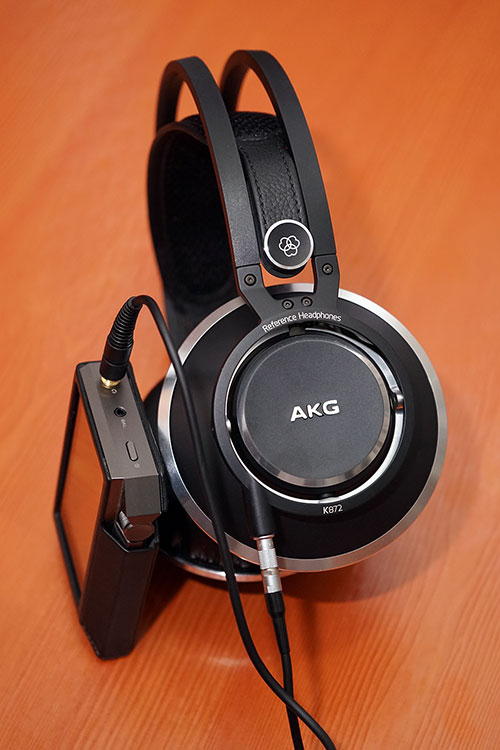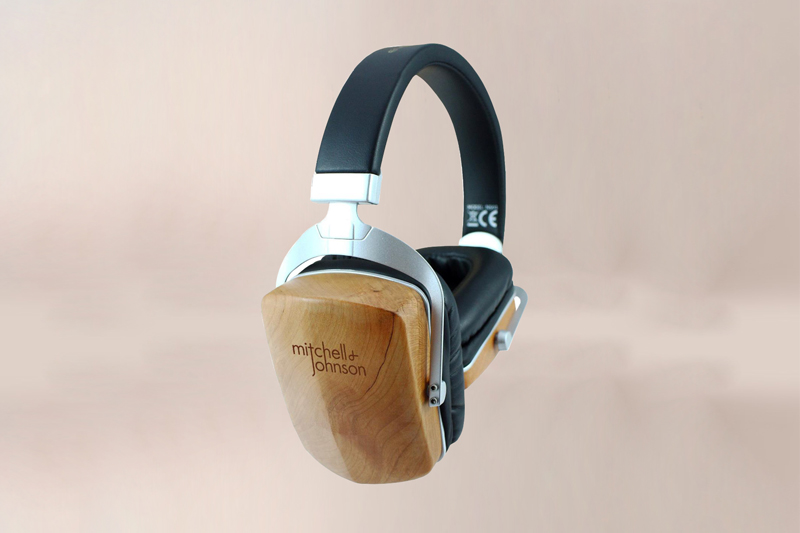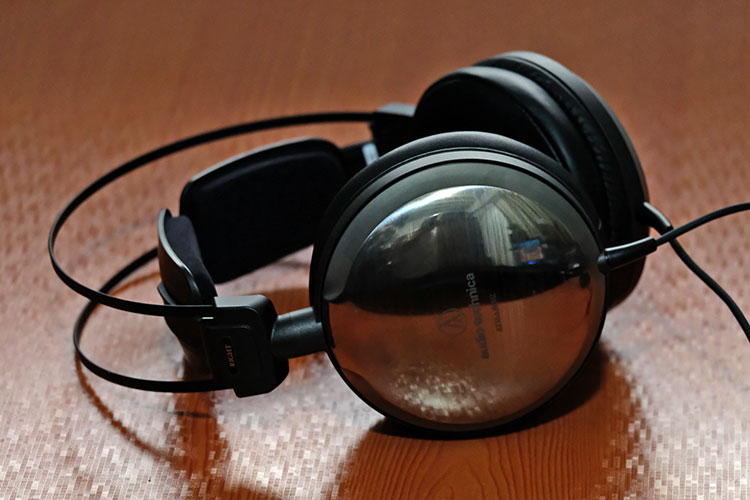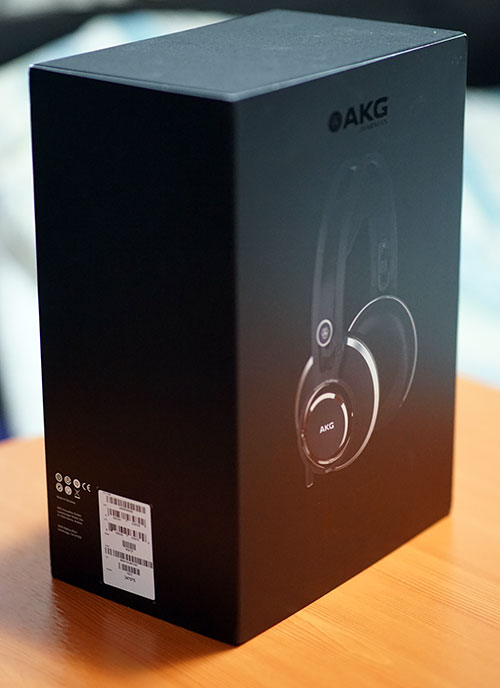K872 Matchability
Efficiency
This is a 36-ohm headphone and much like the K812 the K872 is pretty easy to drive, which by flagship standards is fairly unique these days. You will get decent volume on a smartphone/laptop sound card but you won’t get the dynamics or full range that the K872 can really deliver. For that, a better quality source and the amp will properly drive the K872.
Select DAP Pairings
Modern DAPs represent a good starting point with props to the likes of the Cayin i5, FiiO X7 (AM2/3/5), and the Sony ZX2 for a decent delivery though my preference went to the old Colorfly C4 Pro which produced a wonderfully relaxing and natural sound with a bit of warmth around a more forward vocal delivery that really suited the K872’s excellent vocal staging.
If you want to give the lower end of the K812 a bit more oomph then both the ZX2 and i5 would be my choice over the X7 unless you are using the AM5. The i5 just nudges ahead of the ZX2 if you want a slightly warmer and more forward vocal stage on the K872.
Select Portable Amp Pairings
iBasso D14/Sony PHA-1/RHA Dacamp L1
In most cases, portable amping paired with the K872 gave a noticeable lift in dynamics producing a more vivid presentation and in some cases a little more sparkle in the top end over a DAP-only source/amp.
Modest portable amps such as the D14 from iBasso (Sabre DAC) and the Sony PHA-1 perform very well actually with the D14/K872 sounding spacious and nimble but a touch brighter and more energetic than the more natural-sounding PHA-1/K872 pairing.
One of the most promising pairings with the K872 was RHA’s new DACAMP L1 which combined the spacious staging qualities of the D14 with the thicker more controlled sound of the PHA-1 to produce a very natural tonal quality with excellent clarity and detail. This is a DAC/Amp I think I will be spending a lot of time within the coming weeks.
Cypher Labs Duet & Bakoon HPA-01M
Two of the best portable pairings with the K872 were the Cypher Labs Duet and the Bakoon HPA-01M though for differing reasons.
The Bakoon is awful in terms of absolute silence on the low end whereas the Duet is quite the opposite with a black background on the K872 and next to no noise on low gain. The gain level on the Bakoon is too high for the 36-ohm K872 so if that’s your bag then do not get this pairing.
However, on moderate to higher volume levels in current mode output / low gain the Bakoon produces the most neutral pairing out of all the portable amps tested. It sounds incredibly balanced with excellent speeds and clarity. If you want a bit more low-end body and slam then simply switch over to the voltage mode output on the Bakoon.
The Duet, in contrast, produces a darker signature with the K872 than the Bakoon with a beefier midrange and fuller-sounding bass performance. The K872 and Duet is a more musical pairing than the Bakoon’s flatter tighter response.
Both are excellent in detail retrieval by the way with the edge to the Duet for staging with the K872 in terms of width and depth and the Bakoon teasing a bit more treble extension and detail out of the K872.
Select Desktop Pairings
Unlike other efficient portable flagships such as the T5P, the K812 does pair better on less efficient desktops than I thought it would. For instance, pairing with the Studio 6/DAC-10 was excellent whereas the Beyer T5P noise levels were way too high for my liking making it an impossible match.
You only start to hear any perceptible noise or background hiss once you throw the volume up to fairly high levels. The main issue with the K872 being so easy to drive is more down to the gain levels and how much tweakable volume you have to play with.
Transparency – Sabre or Wolfson
Mind you the K812 signature does show a good level of transparency on system setup coloration and will respond accordingly. DAC setup with either tube or Solid-state also has a subsequent influence on the K872’s tonality.
With the NuPrime DAC-10 tagged onto the Studio 6 that little lick of its Sabre ES9018’s erring neutrality crept into the vocal performance giving it a slightly edgier attack than the Wolfson tuned ALO Audio Continental Mono with the Studio 6 pairing.
With the Mono, I got a richer smoother vocal delivery from the K872 and a more natural tone from the Studio 6 though I lost a little in pure detail as well as treble detail and air in the trade-off.
If you want the Sabre detail but less of the glare to creep into the K812 performance and you are on a bit of a budget, then the Essence HDACC DAC/Amp comes highly recommended.
This was a clean, clear, and more neutral pairing allowing the AKG K872 free reign to show off its much improved and more controlled treble response without any “Sabre Glare” I tended to find on 9018 DAC’s such as the Oppo HA-1. No issues on power, easily driven at around -10 to -15dB, no clipping or distortion on a 32-ohm load.
Tubes – Studio 6 – Sustain84
Switching out the high-end Studio 6 tube setup to the more fiscal friendly and ultra-efficient mid-fi Sustain84 tube amp from Cypher Labs produces an impeccable level of noise control in either low or high gain mode.
This Class A tube amp pairing with the K872 is relatively quick-paced and clean sounding for a tube amp. The K872 faithfully reproduces that fantastic black background that the Sustain84 is known for as well as a strong vocal performance that is incredibly natural sounding.
Even using an ES9018 source (X7 DAC) the Sustain84 really gets on top of any potential harshness and delivers a very smooth tonal flavor from top to bottom.
It loses out to Studio 6’s superior staging capability which pushes the K872’s bottom end with a bit more authority as well as provides a richer fuller-sounding midrange with superior texture and layering.
For me, the Studio 6 better represents that classic analog tube sound paired with the K872 than the cleaner-sounding Sustain84. However, the Sustain84 is less sensitive to Sabre DAC top-end energy and glare than the Studio 6, particularly with the stock tubes and of course is a quarter of the price.
Select Comparisons
The following were selected on the basis of being a closed headphone with variable prices and compromising of differing technologies; one electret, one planar, and one dynamic. Desktop setups used to compare comprised of the ALO Audio CDM & Studio 6 as well as the Essence HDACC DAC & Cypher Labs Sustain84.
Variable portable amp and source setups tested included the FiiO X7/AM3, Cayin I5, Sony ZX2 as well as the Cypher Labs Duet, Sony PHA-1, Bakoon’s powerful HPA-01M, and RHA’s new DAC/AMP.
Mitchell & Johnson MJ2 (Electret)
Technology
The MJ2 is a very interesting electret closed wood design large supraaural headphone that retails for $499 and is marketed by UK-based Mitchell & Johnson. Despite using electrostatic type technology it does not need an equivalent amp. Regular amping will work just fine and at 32 ohms is fairly easy to drive, though a good amp will get the best out of it.
Tonality
Tonally the M2J is a brighter sounding headphone than the K872 with a greater emphasis on midrange and treble energy and very neutral bass response. It’s also a pacey signature with that electret design and will have an edge over most dynamic designs in that respect.
Treble on the M2J is excellent actually and those coming from a pure electrostatic background will appreciate its control and clarity. There is nothing fatiguing whatsoever with the M2J treble with an adequate neutral or natural sounding amp.
In comparison, the K872 has a more holographic and spacious sounding soundstage, a more forward and richer vocal presence, and a darker more laid-back treble response. Detail retrieval on both is excellent however the K872 sounds more natural and refined than the M2J with a more enticing instrumental timbre.
Bass extension on the K872 is superior with more impact and greater weight than the M2J which tends to roll off quickly in favor of a midrange focus. Bass fundamentals are more accurately portrayed on the K872 with a better focus on note texture and layering. I enjoyed the energy and speed of the M2J and
I enjoyed the energy and speed of the M2J and it is something we will have a full review out in the New Year. However, the K872 is the more refined and powerful sounding choice between the two.
MrSpeakers Ether C (v.1.1) (Planar)
Form Factor
The Flow is incoming, we will be reviewing that very shortly indeed however MrSpeakers is still selling the Ether C non-Flow edition and it is priced at the exact same $1500 marker as the K872 so it is worthy of consideration.
Despite the markedly different designs both the Ether C and K872 come at a very similar weight level with the Ether C weighing in at 394g compared to the K872’s 380g.
Fit & Seal
I give the edge in pad comfort to the Ether C though with those fat lambskin pads yet surprisingly both had similar levels of seal, which I had not expected. Kudos to AKG’s unique padding system making them very competitive indeed. Whilst passive isolation levels are similar leakage is a touch higher on the K872 compared to the Ether C.
Cables
Both have detachable cable designs though the Ether C’s hirose connection system is much more amenable to balanced wiring and indeed MrSpeakers can ship the Ether C with a 4-pin XLR variant of their excellent DUM cable.
Having said that in my testing I have never really felt the 36-ohm K872 needed a balanced setup. Sure, it would be interesting but it is not as integral as the balanced cable is to the Ether C performance.
Tonality
Tonally the Ether C has a flatter frequency response than the more musical sounding and energetic K872. Whilst the K872 is darker and smoother sounding headphones compared to the K812 is, in turn, sounds brighter and more energetic in comparison to the Ether C.
The bass weight and body on the K872 are more substantive than the Ether C with a bit more sub-bass presence also. In absolute terms, both headphones are fairly linear and a touch bass light.
Vocal positioning is more forward and vivid sounding on the K872 compared to the smoother but more neutral positioning on the Ether C. For me, the Ether C has slightly superior voicing with brighter sources whereas the K872 could at times slip in a bit more sibilance than the Ether C.
Treble performance is more energetic and lively sounding on the K872 whereas the Ether C top end was thinner sounding in comparison. The Ether C tends to suffer a little from peakiness with poor matching although to be fair the K872 can be pushed to sound a little hot in the lower treble also with poor matching.
Both of them seem to have a disliking for bright sources with the K872 being the more reactive of the two to the type of signal being fed.
ATH A2000Z (Dynamic)
Technology
The A2000Z is a closed full-size circumaural headphone that also sports 53mm drivers and chimes in at $649 which is under half the price of the K812 but sits 2nd from top in the current lineup of ATH headphones.
We have reviewed it previously and found it a delightfully engaging musical headphone with a midrange focus, plenty of energy, and pretty easy to drive at just 44Ω. It is also 100g lighter than the K872 though the isolation is not on par with the AKG’s and the 3D wing system doesn’t feel as intuitively balanced or as comfortable.
Tonality
Tonally the K812 is the smoother more natural sounding of the two and trades the bustling attack-minded energy of the AD2000Z for a more refined and detailed approach.
The instrumental timbre on the K872 unsurprisingly is the more accurate of the two headphones. Vocals on both are forward though tonally the K872 has a better texture and less sibilant prone offering a more life-like representation, particularly with female vocals which sound thinner on the AD2000Z in comparison.
Though both headphones are not bass-heavy I do prefer the performance on the K872 which comes across as better defined than the softer sounding AD2000z and offers more detail, especially in its sub-bass performance.
Our Verdict
Whatever people were unhappy about with the K812 AKG have addressed in the K872. This is a more versatile flagship offering from AKG with a smoother more coherent treble response, a richer note, and a more accurate and very satisfying low end. This is the one I would pick every time given a choice.
It retains a very high degree of musicality but trades some of that energy for smoothness and as a result, I find the K872 by far the easier of the two to match and pair with portable and desktop sources.
Whilst the staging might have a more intimate feel it still sounds very spacious for a closed headphone. The likes of the non-Flow Ether C definitely have a run for the money with the very competitive all-rounder that is the K872.
It loses nothing in the way of form factor either from going closed. The build quality, weight, and efficiency are the same as the K812 and they even throw in a very handsome carrying case instead of an Omega stand so if you are vying for both cans you can either hang one up or carry the other around or vice versa as both fit perfectly.
The only caveat I have is the one hanging over from the original K812 and that is the unique nature of the cable and the inability to go balanced if nothing but for the sake of curiosity. Yet I do not feel it is ever left wanting without a balanced option.
It is not a power-hungry beast, you can have just as much fun with a solid portable system as you can with a decent desktop solution which I guess is exactly how AKG wanted it to be in the first place.
AKG K872 Technical Specifications
| General |
|
||||||||||||||||||
| Audio Interface |
|
||||||||||||||||||
| Dimensions / Weight |
|







